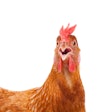The 2017 USPOULTRY Hatchery-Breeder Clinic in Nashville, Tenn., drew a large crowd. Attendees heard from experts on a variety of topics including hatchery basics and feathering, energy efficiency, biosecurity and more.
Dr. Mike Hellwig, director of nutrition for Foster Farms, shared data regarding mortality, feeding and feathering as part of his presentation on “Feathering and Hatchability.” He noted that hatching numbers have been on the decline across the industry over the past eight to nine months and encouraged attendees to adhere to the pattern of weight gain. “I know these numbers have not changed in 40 years, but they haven’t changed because they work. How we feed is more important than what we feed,” Hellwig stated, advising attendees to “get the feed to the birds when they need it.”
Leasea Butler, technical services representative with Cobb-Vantress, and Dr. Bill Stanley, director of global health monitoring for Aviagen, spoke on some of the challenges presented as companies are reducing or eliminating antibiotics. Butler shared that complexes are currently reducing stress, improving gut and intestinal health, and reducing bacteria levels at all stages of the bird’s life. Stanley reminded attendees that while most of the changes being made by industry are voluntary, there is a need to ensure the practices being implemented are sustainable and affordable.
Dr. Eric Benson, professor at the University of Delaware, addressed LED lighting usage in pullet and breeder houses. He explained that LED bulbs are not yet a commodity like other light bulbs. “A lot of the LED technologies are already perceived as being efficient, but often they are more efficient than we realize,” Benson remarked. He added that chickens are more sensitive to UVA light than humans and that different wavelengths can be beneficial to the birds at different stages in their development. Benson concluded by saying, “Energy savings drive light choices. Lighting is one way that growers can lower costs and can often have ownership of the lighting purchasing decisions on their farm.”
Next year’s Hatchery-Breeder Clinic is scheduled for July 10-11, at the Sheraton Grand Nashville Downtown hotel in Nashville, Tenn.















